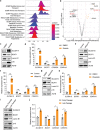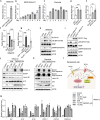Branched-Chain Amino Acid Accumulation Fuels the Senescence-Associated Secretory Phenotype
- PMID: 37964763
- PMCID: PMC10787106
- DOI: 10.1002/advs.202303489
Branched-Chain Amino Acid Accumulation Fuels the Senescence-Associated Secretory Phenotype
Abstract
The essential branched-chain amino acids (BCAAs) leucine, isoleucine, and valine play critical roles in protein synthesis and energy metabolism. Despite their widespread use as nutritional supplements, BCAAs' full effects on mammalian physiology remain uncertain due to the complexities of BCAA metabolic regulation. Here a novel mechanism linking intrinsic alterations in BCAA metabolism is identified to cellular senescence and the senescence-associated secretory phenotype (SASP), both of which contribute to organismal aging and inflammation-related diseases. Altered BCAA metabolism driving the SASP is mediated by robust activation of the BCAA transporters Solute Carrier Family 6 Members 14 and 15 as well as downregulation of the catabolic enzyme BCAA transaminase 1 during onset of cellular senescence, leading to highly elevated intracellular BCAA levels in senescent cells. This, in turn, activates the mammalian target of rapamycin complex 1 (mTORC1) to establish the full SASP program. Transgenic Drosophila models further indicate that orthologous BCAA regulators are involved in the induction of cellular senescence and age-related phenotypes in flies, suggesting evolutionary conservation of this metabolic pathway during aging. Finally, experimentally blocking BCAA accumulation attenuates the inflammatory response in a mouse senescence model, highlighting the therapeutic potential of modulating BCAA metabolism for the treatment of age-related and inflammatory diseases.
Keywords: BCAA; SASP; age-related inflammation; mTORC1; senescence.
© 2023 The Authors. Advanced Science published by Wiley-VCH GmbH.
Conflict of interest statement
The authors declare no conflict of interest.
Figures





References
-
- Biswas D., Duffley L., Pulinilkunnil T., FASEB J 2019, 33, 8711. - PubMed
-
- Hormoznejad R., Zare Javid A., Mansoori A., Sport Sci. Health 2019, 15, 265.
-
- Le Couteur D. G., Solon‐Biet S. M., Cogger V. C., Ribeiro R., De Cabo R., Raubenheimer D., Cooney G. J., Simpson S. J., Ageing Res. Rev. 2020, 64, 101198. - PubMed
Publication types
MeSH terms
Substances
Grants and funding
LinkOut - more resources
Full Text Sources
Molecular Biology Databases
